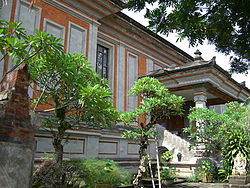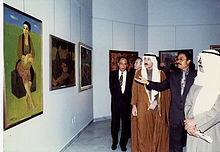- Museum Rudana
-
Museum Rudana Established 11 August 1995 Location Peliatan, Gianyar Regency, Bali Indonesia Website museumrudana.com Museum Rudana or Rudana Art Museum was built in Peliatan, Gianyar Regency, Bali, by Nyoman Rudana. It is built following the concept of the Bali philosophy Tri Hita Karana, where art has a great contribution in spreading world peace, prosperity, and brotherhood amongst mankind. The humanist concept of the Rudana Art Museum is the main philosophy of Nyoman Rudana in collecting paintings in the museum.
Contents
History
Its blessing ceremony was held on August, 11 1995 as part of the commemoration of the 50th Anniversary of Indonesian Independence with its Golden Indonesian Spirit. President Suharto officially opened it on December 26, 1995.[citation needed]
Architecture
The 500 square meter building of Museum Rudana was built on 2.5 acres (10,000 m2) of land and its cornerstone was laid on December 22, 1990.[citation needed]
Nyoman Rudana conceptualized the building, which is three stories tall holding Balinese architecture and philosophical artifacts. Tri Angga, the three parts of a human body: the head, trunk, and legs; Tri Manggala, the division of a compound into 3 sections: the inner, middle, and outer sections; Tri Loka, the concept of the universe which is divided into bur, bwah, swah: the worlds beneath, intermediate and above. These philosophical concepts, connected with the fine art development of Bali, are reflected in the regeneration of artists from the past to the present, a continuation of which is comparable to a link of sustainable golden thread.[citation needed]
The outer walls of the museum reflect the national flag of Indonesia: red and white. The red part is made up of red bricks and the white is made up of sandstone.
Location
Museum Rudana is located in Peliatan village, in the Ubud sub-district of Gianyar Regency, Bali, Indonesia, about 16 km from Denpasar, the capital city of Bali, in the Museum Rudana compound.
Collections
Museum Rudana exhibits more than 400 pieces of fine art and sculpture made by various Indonesian artists. The arrangement of paintings represents a harmony of style inline with the philosophical concept of the building.
On the first and second floor, the works of modern Indonesian artists are displayed, such as those of Affandi, Basuki Abdullah, Srihadi Soedarsono (famous for his series of Borobudur paintings), Nyoman Gunarsa, and Made Wianta. The works of post-modern Indonesian artists such as Nyoman Erawan and Made Budhiana are also presented. Museum Rudana also has many paintings depicting famous temples in Indonesia such as Besakih in Bali and Prambanan in Central Java.
On the third floor, various traditional work of traditional Balinese masters from Ubud and Batuan such as those of I Gusti Nyoman Lempad, I Gusti Ketut Kobot, and many others are exhibited.
The museum also exhibits the works of prominent foreign artists who reside in Bali such as Don Antonio Blanco (Spain), Yuri Gorbachev (Russia), Jafar Islah (Kuwait) and Iyama Tadayuki (Japan).
Exhibitions
Museum Rudana conducted several exhibitions overseas. In 1997 and 1998, an era where monetary crisis occurred in Indonesia, it held exhibitions in Kuwait City, Kuwait and in Rome, Italy in 2000, where Nyoman Rudana received the L’albero dell’umanita (The Tree of Humanity) award from the Italian Government.
Regular exhibitions are held several times a year, with the biggest one usually taking place in August as a commemoration of its anniversary. The 4th anniversary in 1999 and the 8th in 2004 were commemorated by presenting The Ksatria Seni Awards to fellow artists who dedicated their works for the development of the Indonesian arts.
References
- Mann, Richard, 2006. Treasures of Bali – A Guide to Museums in Bali. Gateway Books International, UK. ISBN 979-99853-4-X
- August 2007, Museum Rudana Buletin (issued commemorating the 12th Anniversary of Museum Rudana).
- 2004, 8th Anniversary of Museum Rudana - Ksatria Seni Award 2004 catalog
- 1995, Museum Rudana catalog.
External links
- Museum Rudana Bali on Online-news 7 Feb07
- Jakarta Post 23 August 2007 : Museum Rudana Marks its 12th Anniversary
- PlanetMole.Org : Modern Indonesian Masters Painting Exhibitions, 2007
- Ubud News, 28 August 2004 Rudana Celebrates with Nahappan
- Bali Discovery Tours 8 Oct 2007 Modern Indonesian Masters : 8 Senior Indonesian Artists Celebrate the 12th Anniversary of Ubud's Museum Rudana in a Joint Exhibition
- Jakarta Post 23 August 2007 - Museum Rudana marks 12th anniversary
Categories:- Museums in Bali
- Balinese art
Wikimedia Foundation. 2010.





